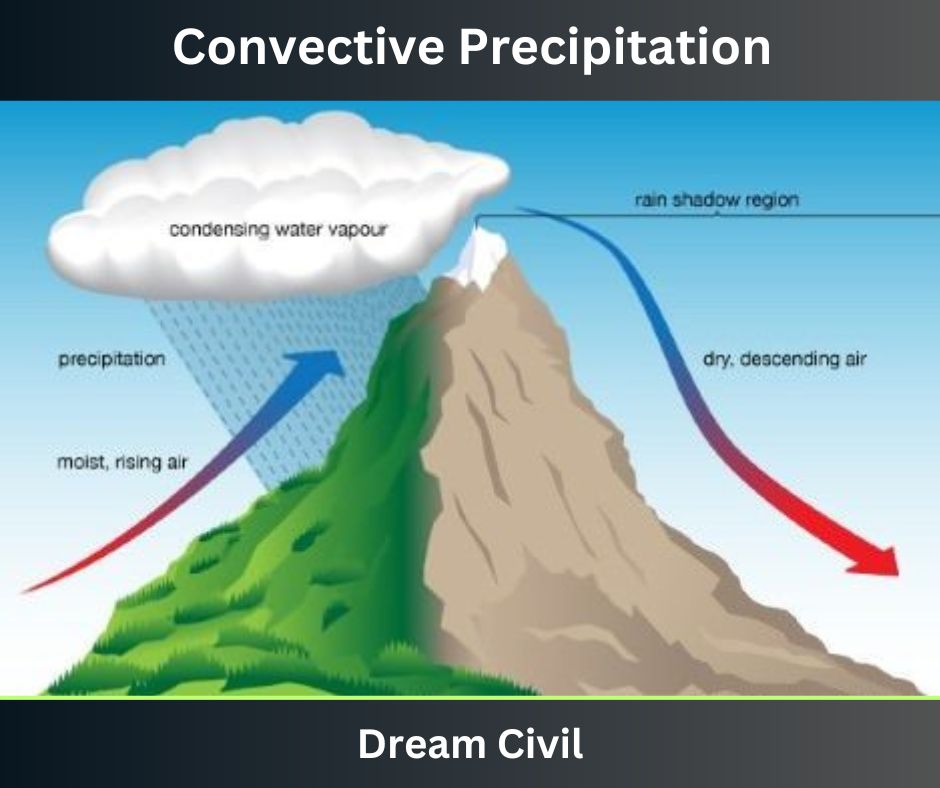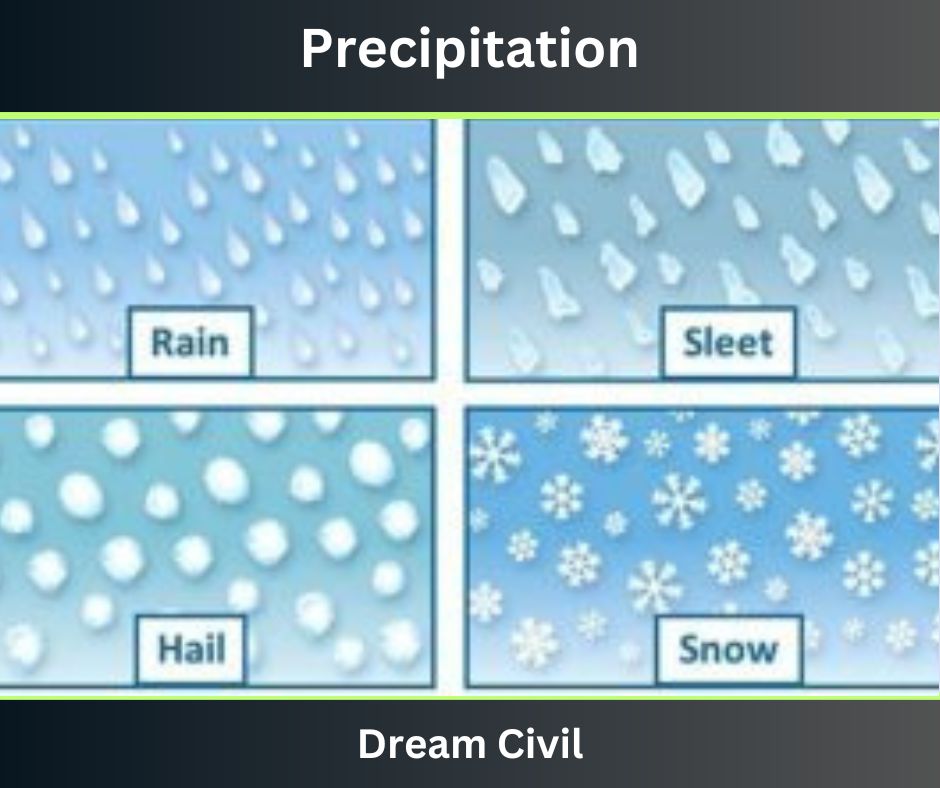Table of Contents
Precipitation in a very simple sense can be understood as the process by which all the water reaches the earth from the atmosphere.
Meteorologically,
Precipitation may be defined as the product resulting from the condensation of water vapor that falls on the earth under the action of gravity from the clouds.
The main forms of precipitation are rain, snow, hail, drizzle, sleet, ice pellets, hail, and graupel.
Rain and snow are the major forms of precipitation that contribute to the water resources particularly the freshwater resources of the earth.
According to the statistical reports, approximately 505,000 km3 of water falls as precipitation every year.
It is an important part of the hydrological cycle of the earth and thereby is necessary for maintaining balance in the Earth.
1. Importance of Precipitation
Its importance is as follows:
1. It is an essential part of the water cycle of the Earth. Thus, it is necessary for maintaining the natural balance.
2. It is a major source of fresh water on Earth.
3. Precipitation such as rainfall and its distribution forms a leading feature of the climate.
4. It is necessary for regulating the global energy flow i.e. the movement of heat.
2. Causes of Precipitation
The causes of precipitation are as follows:
a. Frontal Activity
Frontal precipitation occurs as a consequence of the slow ascent of air in synoptic systems (on the order of cm/s), such as over surface cold fronts, and over and ahead of warm fronts.
A similar ascent is seen around tropical cyclones outside of the eyewall and in comma-head precipitation patterns around mid-latitude cyclones.
Frontal Activity is also called stratiform or dynamic precipitation.
b. Convection
It is the most common cause of precipitation in tropical areas.
Convectional clouds fall as showers with rapidly changing intensity.
Convective precipitation falls over a certain area for a relatively short time, as convective clouds have a limited horizontal extent.
It is also called showery precipitation
c. Orographic Action
Orographic precipitation occurs on the windward (upwind) side of mountains and is caused by the rising air motion of a large-scale flow of moist air across the mountain ridge, resulting in adiabatic cooling and condensation.
3. Occurrence of Precipitation
When sufficient moisture is present in the atmosphere; precipitation of various forms occurs. For such precipitation to occur, sufficient particles and nuclei such as salt particles, by-products of combustion, etc must be present in the atmosphere along with the moisture.
Also, the weather conditions must be suitable for the condensation of the moisture or water vapor to occur.
As these water vapors undergo condensation under favorable weather conditions; the nuclei and particles form precipitation in the form of droplets of water. Then, the turbulence of the wind aids in the suspension of the water particles. These water particles come together and thus form larger droplets of water with sizes greater than 0.1 mm in diameter. These droplets are capable of falling under the effect of gravity.
4. Forms of Precipitation
The various forms of precipitation are as follows:
a. Rain:
Rain in the form of precipitation occurs in the form of water drops.
These water drops are of a size larger than 0.5mm. The maximum size of the raindrop is approximately 6mm.
In case, the droplets are larger than 6mm, they break down into smaller droplets and fall on the earth.
Rainfall is an essential form of precipitation that contributes significantly to the water resources of the earth as well as an important constituent of the ecological cycle.
The magnitude of rainfall even indicates the high temporal and spatial variation. Such variations are responsible for the occurrence of various extreme hydrological conditions such as floods, famines, and droughts.
| Type of Rainfall | Intensity (mm/h) |
| Light | Trace to 2.5 |
| Moderate | 2.5 – 7.5 |
| Heavy | >7.5 |
b. Snow:
Snow is a form of precipitation that consists of crystals of ice in a flaky form.
It usually has an average density of 0.1gm/cc.
Snow is also a chief contributor to the water resources of the earth.
c. Drizzle:
It is a form of precipitation that is similar to rain.
However, the drizzle consists of water droplets with a size of less than 0.5mm.
The intensity of the drizzle is mostly greater than 1mm/hr.
d. Sleet:
Sleet is a form of precipitation that exists in the form of frozen droplets of rain.
The freezing of the droplets mostly occurs when the droplets pass through the air at freezing temperatures.
e. Glaze:
The glaze is also commonly referred to as freezing rain.
It is the form of precipitation that is formed when the rain or drizzle comes in contact with the cold ground usually at 0 degrees Celsius.
f. Hail:
Hail is the form of precipitation that exists in the form of lumps or pellets with a size greater than 8mm.
5. Types of Precipitation
As mentioned earlier, precipitation occurs when the water vapor or the moist air present in the atmosphere undergoes condensation.
Condensation takes place when such a mass of water vapor or moist air cools down and saturates with the same amount of moisture.
Such a process of cooling of the moist air mass occurs when the mass of the moist air moves significantly upwards to higher altitudes.
The mass of the moist air can be lifted to higher altitudes commonly by three methods.
Based on these methods of lifting the moist air, the precipitation can be classified into the following three types:
i. Cyclonic Precipitation
It generally refers to the precipitation that occurs by the cyclonic movement or action of the moist mass of air.
A cyclone is a phenomenon that occurs in the atmosphere consisting of low pressure and circular wind motion. Thus, cyclonic precipitation is the type of precipitation that occurs due to such cyclonic action with the aid of the pressure difference.
Cyclonic precipitation can be classified into the following:

a. Frontal
It is the hot moist air mass boundary that occurs due to the expansion of air near the frontal surface.
b. Non-Frontal
It is a cold air mass boundary that occurs due to the movement of the cold mass of moist air that results in precipitation.
ii. Convective Precipitation
Convective precipitation is the type of precipitation that results from the convective movement of the air.
In actuality, the air present above the surface of land gets heated and this warmer air being lighter moves up, cools down and thus precipitates.
The convective precipitation mostly occurs in varying intensities and in the form of showers.
The areal extent of such precipitation is relatively smaller and usually is in the range of less than 10 km in diameter.

iii. Orographic Precipitation
It is the type of precipitation that occurs by the orographic action i.e. the movement of the moist mass of air on the windward side of the mountain.
In other words, moving air masses have a chance to strike barriers like mountains. Once they strike, they rise which causes condensation and precipitation.
The precipitation is greater on the windward side of the barrier compared to the leeward side of the barrier.

6. Water Balance Equation
The water balance equation is the statement of the law of conservation of mass. It is also called the continuity equation or conservation equation.
In other words, it is the balance of the input and output of water within a given area taking into account net changes in storage.
It can be defined by the following relationships.
Mass inflow – Mass outflow = change in Inflow storage
If the density of inflow and outflow is the same, then
Volume Inflow – Volume Outflow = Change in storage
Here, the main source of inflow is precipitation and outflows are surface runoff, evaporation, transpiration, interception, etc.
The relationship between rainfall and runoff is a very complex phenomenon as the parameters involved in the relationships are not very accurately determinable. Various components of water balance within the basin.
General water budget equation in hydrology for time internal Δt.
P-(R+G+E+T)= ΔS
Where,
P= Precipitation
R= Surface runoff
G= Net groundwater flows out of the catchment
E= Evaporation
T= Transpiration
ΔS= Change in storage
All the terms in the equation have the dimensions of volume. Alternatively, these terms can also be expressed in the unit of depth, e.g. m, cm, mm.
a. To convert depth to volume, multiply depth by catchment area.
b. To convert flow rate to volume, multiply flow rate by time duration.
c. To convert volume to depth, divide the volume by catchment area.
In the case of other inflow besides precipitation, the water balance equation is
(P+I)-(R+G+E+T)= ΔS
I = other inflow
For the long term, e.g. annual water balance, change in storage is zero. In such a case, the general water balance equation is,
Precipitation – Runoff = Evaporation
7. References1. Content Filter & Authenticity Checking Team, Dream Civil International (Our team checks every content & detail to maintain quality.) |
| Read Also: Water Balance Equation Numerical |

